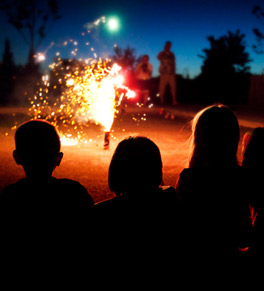rubbing alcohol left big burn mark on face what to do

Watching fireworks from a safe altitude is all-time, say UCI Health experts.
Have you heard that smearing butter on a burn down, pressing a cut murphy against it or icing it tin can help promote healing and ease the hurting?
None of these methods are recommended, says Dr. Nicole P. Bernal, a surgeon and burn specialist with the UCI Regional Burn down Center. In fact, these age-old habitation remedies not only don't work, they likewise can practice more than harm to burned skin.
What is the right way to treat a burn? The showtime affair to consider is how severe information technology is, says Bernal. Burns are mostly classified by the depth of damage to the skin:
Start-degree burns
- These burns affect only the peel's surface, or epidermis, and usually effect in redness and balmy pain.
- Overexposure to the sun can cause a first-caste burn.
Almost first-degree burns don't crave medical attention, says Bernal. She recommends rinsing the fire area with cool water for 5 to ten minutes or until the pain subsides. Adjacent, apply a moisturizing balm and if needed, take an over-the-counter pain reliever for a few days. If the hurting doesn't subside, see a medico.
Second-degree burns
- These burns penetrate to the second layer of peel, or dermis.
- They are usually bright red with a moist or blistered advent.
- Scalding with extremely hot water or other liquid may crusade this type of burn.
- Some second-degree burns may require a skin graft or skin substitute to heal.
Baking and sluffing of skin is common with second-degree burns and can become infected, which is why Bernal advises consulting a doc.
Third-degree burns
- These burns involve all layers of the peel and are usually dry or leathery to the touch.
- They can appear cadaverous or charred blackness or brown.
- If the burn down has damaged nerve endings, the patient may have no sensation of hurting.
- Causes can be hot oil, friction, touching hot surfaces such as a stove, crimper fe or a motorcycle muffler or fifty-fifty a chemical fire.
These more than serious burns tin lead to devastating injury, including loss of function or limbs, disfigurement and recurring infection. Astringent burns can impairment muscles and other tissue that bear upon every arrangement of the trunk, and they can issue in death.
3rd-degree burns need immediate medical attending and ofttimes require a peel graft or skin substitute to heal, Bernal says.
Center versed in all aspects of burn care
The UCI Regional Burn down Center at UCI Medical Center uses a multidisciplinary team of fire-specialist surgeons, nurses, wound care specialists, physical therapists, social workers, case managers and psychologists to manage all aspects of burn care.
It'southward the merely fire middle in Orange County verified by the American College of Surgeons and the American Burn Association. It includes an inpatient unit and an outpatient clinic.
Treating burns at domicile
Many minor burns can be treated at abode. Bernal offers these exercise'south and don'ts:
Practice:
- Run cool water (not common cold or icy) for v to 10 minutes over a burn smaller than your hand.
- Seek medical attending for any burn larger than your hand — fingers to wrist — or if the burn affects the feet, face, eyes or genitalia.
- See a doctor if you have diabetes and you fire your pes.
- Become immediate care if your cell phone or e-cigarette explodes in your pocket, if you fall into a fire pit or whatsoever time your clothes catch fire.
- Remove clothing and jewelry almost a burn, but don't try to peel off clothing stuck to the fire.
Don't:
- Touch or soak a serious burn down. Cover it with something dry and get to a hospital or burn clinic.
- Popular blisters. Just if they practise burst, gently peel abroad the dead peel and then germs don't take a home to alive in.
Handling for small burns
For commencement-degree or 2nd-degree burns smaller than near two inches in bore, Bernal recommends the following home-treatment steps:
- Wash the area daily with mild lather.
- Apply an antibiotic ointment or dressing to go on the wound moist.
- Cover with gauze or a Band-Help to proceed the area sealed.
- Apply antibiotic ointment oft to burns in areas that cannot be kept moist.
Related stories
- What's in your habitation first-assistance kit? ›
- How to properly care for a wound ›
- Beyond sunscreen: How to protect yourself from the sun ›
Mail a Annotate
pennefatherbove1971.blogspot.com
Source: https://www.ucihealth.org/blog/2018/05/treating-burns